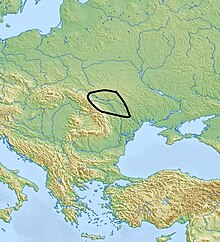Loading AI tools
From Wikipedia, the free encyclopedia
The Komarov culture was a Bronze Age culture which flourished along the middle Dniester from 1500 BC to 1200 BC.
 | |
| Geographical range | Middle Dniester |
|---|---|
| Period | Bronze Age |
| Dates | ca. 1500–1200 BC |
| Type site | Komarov |
| Preceded by | Corded Ware culture |
| Followed by | Chernoles culture |
Few settlements from the Komarov culture have been found. One settlement at Komarov, from which the culture is named, contained twenty small single-roomed houses.
The Komarov culture is best known for its inhumation burials. These are set into a stone- or timber-covered grave covered with a tumulus. Cremations and flat grave burials are also known. Decorations found on ceramics, and the presence of stone rings and cromlechs around the base of the tumuli, indicate that a sun cult existed among the Komarov people.
The Komarov culture is believed to have originated within the Corded Ware horizon, with which is shares numerous similarities, including burial rites, ceramics and metallurgical traditions. It is closely related to the Trzciniec culture. The Komarov culture is usually associated with the evolution of the Proto-Slavs or the Thracians.

Seamless Wikipedia browsing. On steroids.
Every time you click a link to Wikipedia, Wiktionary or Wikiquote in your browser's search results, it will show the modern Wikiwand interface.
Wikiwand extension is a five stars, simple, with minimum permission required to keep your browsing private, safe and transparent.